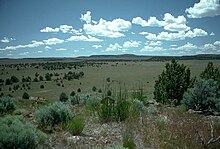

The Oregon Desert Trail is a network[1] of trails, cross country travel and two-track dirt roads across the Oregon High Desert. The trail is approximately 750 miles long,[2] with termini located near Bend, Oregon, and near the Idaho border at Lake Owyhee State Park.[3][4]
The route is on existing trails and across tracts of public land—mostly Bureau of Land Management, much of it wilderness study area. The west end of the trail is on the northern border of Oregon Badlands Wilderness and heads south. It meanders widely to take in public land throughout southeastern Oregon: Diablo Peak, Fremont National Forest, Hart Mountain National Antelope Refuge, Steens Mountain, the Pueblo Mountains, the Trout Creek Mountains, and the Owyhee River Wilderness. It passes through the tiny cities of Christmas Valley, Paisley, Plush, Frenchglen, Fields, McDermitt, Rome, and Adrian.[5] The trail runs South East from Central Oregon, towards Lakeview.[6] It touches on the Oregon-Nevada border at of Denio, Nevada and again at McDermitt, Nevada. The route zigzags eastward to within 15 miles (24 km) of the southeastern state corner while following the West Little Owyhee River downstream and then turns northward as it merges to form the Owyhee River. The trail's ends are west-northwest to east-southeast (96° true) of each other by 195 miles (314 km). The route was developed by the Oregon Natural Desert Association (ONDA).[2]
The Oregon Desert Trail is set apart from other similar trails, such as the Pacific Crest Trail, in that it: offers more solitude - there is little to no traffic on the route,[7] one must rely on their own navigational skills - there is no dedicated signage, and it is a very dry trail with extended water carries and water caches necessary. This trail is not recommended for beginners, as it is difficult and requires extensive planning, has limited access to water, limited resupply locations, and requires hikers to rely on their navigational skills.[8]
Bikes are allowed on parts of the trail,[9] but are not practical in some areas[9] and are not allowed in wilderness areas.[10] Sections can be paddled, explored on skis, horseback, or biked.
- ^ "Archived copy". www.mensjournal.com. Archived from the original on 2015-04-07.
{{cite web}}: CS1 maint: archived copy as title (link) - ^ a b Burns, Joe (8 June 2013). "Bend woman blazing trail to preserve high desert". KTZV. Retrieved 7 June 2013.
- ^ Morical, Mark (5 June 2013). "Bend hiker hopes to hike trail first". The Bulletin. Retrieved 6 June 2013.
- ^ "Across the Oregon Desert Trail". Oregon Natural Desert Association. Retrieved 6 June 2013.
- ^ Richard, Terry (6 October 2012). "Oregon Desert Trail envisioned as 750-mile Bend-to-Idaho crossing". The Oregonian. Retrieved 6 June 2013.
- ^ See detailed map
- ^ Neville, Tim (19 August 2011). "Bivouacking in Oregon's Back of Beyond". The New York Times.
- ^ "Oregon Natural Desert Association - Explore the High Desert".
- ^ a b Richard, Terry (6 June 2013). "Sage Clegg, first through hiker on the Oregon Desert Trail, begins 800-mile trek". The Oregonian. Retrieved 7 June 2013.
- ^ Bradley, John (16 February 2010). "Spurning Rubber". Outside.